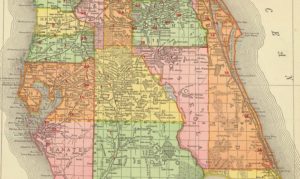Old Lauderdale Becoming Broward

It was a long time coming, but not so easy to carve out Broward County. The area’s previous incarnations had been under the Spanish, “East Florida” under the British, St. John’s County in 1821, Monroe County in 1823, Dade County in 1836, Mosquito County later in 1836, St. Lucia County in 1845, Brevard County in 1860, Palm Beach County in 1909 and then Dade again.
But finally in 1915, this area was no longer an afterthought, a space between Dade and Palm Beach. And our city became the new county seat.
Yet it was not inevitable that things would happen this way. In 1908, three years before Fort Lauderdale was incorporated, two adjacent towns were. And one was hungry. This letter from a prominent citizen appeared in the Miami News Record in 1908.
Dania has five stores, one hotel, a stone church, the LaBree boot works, a blacksmith shop, Mrs. Palmer’s Bakery, Coulters Jewelry, two lumber yards, one lawyer, a new cement block school and a jail….The Citizens of Dania now contemplate taking in more territory next summer as far as the New River. If the Fort Lauderdale citizens on the north side of the river wish to be incorporated in Dania, Dania will have no problem.
Meanwhile to the north, Pompano and Deerfield for a time became part of Palm Beach County. Would our unincorporated settlement of mostly vegetable farmers be next?
To give you a feeling of the times, Pompano, once incorporated, enacted a raft of laws. Livestock could no longer be driven in the streets, and jail or fines awaited “rogues and vagabonds, common pipers and fiddlers.” (There goes the early Irish music scene.)
Two major developments sent territorial change in a different direction. One was the great land boom in Fort Lauderdale, sparked by Gov. Napoleon Bonaparte Broward’s campaign to drain the Everglades for a “New Fertile Crescent.” People across the U.S. bought the concept, and our city became the big kid on the block as people kept streaming in. (Though a sizable portion left in anger when they discovered their land was underwater.)
So on March 27, 1911, 45 of the town’s qualified voters got together in the new schoolhouse and voted for incorporation. They debated the city’s size, whether it should be 1.5 miles square or two miles square. They decided two miles was just too big.
One of their first acts came in the area of sanitation, then a crisis. The new council raised $230 to buy a wagon and a draft animal to facilitate “emptying the privies and disposing of refuse.” They called the beast of burden “The Sanitary Mule.”
With our growth, there was no more talk of annexation by Dania. In 1913, the business community thought it was time to break away from Dade County altogether, which in 1909 had lost another chunk of its territory to the newly endowed Palm Beach County (including Deerfield and Pompano).
Fort Lauderdale would create a new county around itself, including Dania, Hallandale, Zona and Pompano. (“Zona” was a small town roughly corresponding to present-day Davie, whose residents came up from the Panama Canal Zone to help build Governor Broward’s drainage canals.)
At that time, this new-county effort failed because the southern cities wanted to stay with Dade and Pompano wanted to stay with Palm Beach.
But then, along came that second major event – Prohibition.
Miami, a tourist town, wanted the “wet” version, but the county overall voted the dry option. Next thing you know, Dade was no longer resisting a new county. Pompano and Deerfield had also come around.
So after all the boundary details were hammered out, the state legislature passed a bill unanimously creating a new county named after the “swamp-draining” governor. History books list its towns: our city, Dania, Pompano, Hallandale, Deerfield, Davie (Zona changed its name), Progresso and Colohatchee.
#fortlauderdale #ftlauderdale #andrewbarnett

No Comments